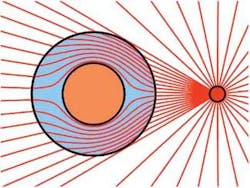CONFERENCE REVIEW: Meta 2006 highlights random, periodic optical metamaterials
Photonic Metamaterials: from Random to Periodic (Meta; June 5-8, Grand Bahama Island, The Bahamas) brought together leading researchers in three areas of science and technology: photonics of random media, with its deep and challenging physics; photonic crystals, which has matured rapidly with the creation of intricate structures; and metamaterials, whose rapid growth has been spurred by dreams of superseding long-accepted limits of optical resolution and detectability. At Meta 2006, a new topical meeting held by the Optical Society of America (Washington, D.C.), the synergy between these fields was palpable and led to discussions between groups in which participants could reimagine key issues in their own islands of expertise (see Fig. 1).
Three introductory “grand talks” were given by leaders in their fields, John Pendry (Imperial College; London, England), Ad Lagendijk (Fundamenteel Onderzoek der Materie; Utrecht, The Netherlands), and Sajeev John (University of Toronto; Toronto, Ont., Canada). The conference concluded with wrap-up presentations by John Pendry, Ad Lagendijk, and Yurii Vlasov (IBM; Yorktown Heights, NY), which emphasized the state of the art of the three fields and discussed fundamental issues raised at the meeting.
Designed metamaterials have developed at breakneck speed because of improved nanofabrication capabilities and the development of subwavelength-scanning imaging techniques and have opened the way for many photonic possibilities unattainable in naturally existing materials. The structural units of metamaterials can be tailored in shape and size; the composition and morphology can be artificially tuned, and inclusions with desired functionality can be precisely placed. Meta 2006 brought together experts from various disciplines to consider a broad range of materials, from disordered to periodic, with a range of structures and applications for manipulating light with unprecedented precision on the macro- and nanoscales.
Although the field of metamaterials includes a wide variety of engineered materials with designed optical properties, the term was originally coined in connection with negative-index materials (NIMs), also referred to as left-handed materials. Such metamaterials promise to create entirely new modalities for manipulating light with revolutionary impact on present-day optical technologies. Recent experimental breakthroughs in bringing NIMs to the optical regime were described in talks by Stefan Linden (Max Plank Institute; Karslruhe, Germany; see www.laserfocusworld.com/articles/231731) and one of the authors (Vlad Shalaev), whereas Xiang Zhang (UC Berkeley; Berkeley, CA; see www.laserfocusworld.com/articles/199240) and Richard Blaikie (University of Canterbury; Christchurch, New Zealand; see www.laserfocusworld.com/articles/229685) outlined progress in developing the superlens and its applications for nanoscale photolithography. The exchange of ideas from the NIM field and from more-mature fields of photonic crystals and random media was a distinguishing feature of the meeting.
Great progress was reported in cloaking objects by completely excluding electromagnetic fields from them and thereby rendering them invisible (see figure). Graeme Milton (University of Utah; Salt Lake City, UT), Nader Engheta (University of Pennsylvania; Philadelphia, PA), and John Pendry presented three different approaches.1
The photonics of random media
New perspectives were given on the photonics of random media and, particularly, on the so-called Anderson transition (a switchover from propagating, wavelike behavior to spatially localized photons that are trapped by multiple scattering). There were three reports of the transverse localization of light traveling in samples that are uniform in the direction of the incident beam but disordered in the perpendicular plane, a circumstance which had been proposed by De Raedt, Lagendijk, and de Vries.2 Photon localization and the impact of nonlinearity was studied in parallel clusters of optical fibers (Thomas Pertsch et al., Friedrich-Schiller University/Institute for Physical High Technology; Jena, Germany), in a photorefractive crystal that had been exposed to a random 2-D speckle pattern interfering with stronger writing beams (Tal Schwartz et al., Technion; Haifa, Israel), and in a linear array of parallel optical waveguides (Yoav Lahini et al., Weizmann Institute of Science; Rehovot, Israel).
The impact of localization in the time domain was shown in the increasing suppression of transmission with delay from an exciting pulse for localized microwave radiation (Andrey Chabanov et al., University of Texas at San Antonio/Queens College, Flushing, NY) and optical radiation in the critical regime in a sample with ratio of mean free path to wavelength of 4p (Christof Aegerter et al., University of Konstanz; Konstanz, Germany). The creation of spatially extended states when modes spectrally overlap, termed necklace states by John Pendry, was reported in measurements of pulsed optical transmission through random porous-silicon layers (Jacopo Bertolotti, European Laboratory for Nonlinear Spectroscopy; Florence, Italy), and in microwave measurements of the field within random waveguides (Patrick Sebbah, CNRS/Queens College). These states account for the bulk of transmission in 1-D systems.
Robin Kaiser of the Nonlinear Institute of Nice, France, discussed new ways to study Anderson localization at atomic resonances using backscattered light from cold atoms. The prospects for novel coherent propagation effects in these systems arising from internal degrees of freedom (Zeeman sublevels) and cooperative effects such as superradiance were discussed by Eric Akkermans of the Technion.
Vladimir M. Shalaev and Azriel Genack
REFERENCES
1. J.B. Pendry et al., Science 312(5781) (June 23, 2006).
2. H. De Raedt et al., Phys. Rev. Lett. 62(1) (Jan. 2 1989).
VLADIMIR M. SHALAEV and AZRIEL GENACK cochaired Metamaterials 2006. Shalaev is the Robert and Anne Burnett Professor of Electrical and Computer Engineering and a professor of biomedical engineering at Purdue University (West Lafayette, IN); e-mail: [email protected]. Genack is a Distinguished Professor at the Department of Physics, Queens College of the City University of New York (Flushing, NY); e-mail: [email protected].

